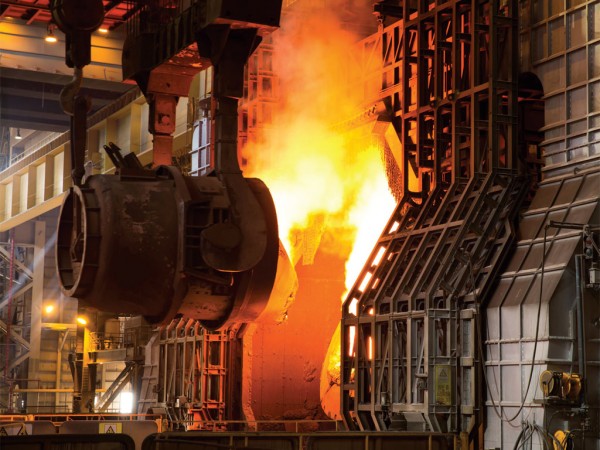But for now, continued growth is foreseen
Experts differ on the numbers, but the consensus appears to be that global steel demand will continue to grow in 2019, although at a slower rate than in the last two years. Steel demand grew by nearly four percent in 2018 but is expected to grow by less than one and a half percent this year. That could indicate a slowdown in the global economy, perhaps foretelling a recession in mature economies where the deceleration will be most pronounced. China, the world’s largest producer and consumer of steel, is a whole different ballgame.

Global steel production reached 1.81 billion tons in 2018, up 4.6% over 2017, according to figures released by the World Steel Association. Steel production increased across the board last year, except in Japan and the European Union, which each saw a contraction of a fraction of percent. In the EU, production out of Germany, France, and Spain all dropped, while Italy’s was up by 1.7% over 2017. Production in the Middle East saw an increase of 11.7 percent, with Iran’s production spiking by 17.7% over 2017.
As far as demand goes, Worldsteel’s numbers show 1.66 billion tons in 2018, an increase of 3.9 percent over 2017. In 2019, its forecast is that global steel demand will grow by 1.4% to reach 1.68 billion tons. Note that global production last year exceeded demand last year by 150 million tons.
“In 2018, global steel demand continued to show resilience supported by the recovery in investment activities in developed economies and the improved performance of emerging economies,” said Al Remeithi, Chairman of the Worldsteel Economics Committee. “While the strength of steel demand recovery seen in 2017 was carried over to 2018, risks have increased. Rising trade tensions and volatile currency movements are increasing uncertainty.”
US Plants
In the United States, Steel Dynamics reported record steel shipments of 10.6 million tons and steel fabrication shipments of 642,000 tons. The company also reported record sales, operating income, and net income.
“In 2018, the domestic steel industry benefited from a steady improvement in underlying steel consumption,” said Steel Dynamics CEO Mark Millett, “based on strength from the automotive, construction, and energy sectors. Increased steel consumption, coupled with generally lower finished steel imports, created a strong market environment.
“We believe the market dynamics are in place for domestic steel consumption to continue to increase this year,” he added.
The company’s planned flat roll steel mill that was announced late last year, “with capabilities beyond existing electric arc furnace flat roll steel producers,” said Millett. “We have targeted regional markets that currently represent over 27 million tons of relevant flat roll steel consumption, which includes the growing 16 million ton Mexican flat roll market.”
Steel Dynamics’ new steel mill will boast a capacity of 3.0 million tons and the capability to produce latest-generation high-strength steel products. The project will include value-added finishing lines and a paint line. The plant’s product offering will include flat-roll steel products, Galvalume, and painted steel, to serve the energy, automotive, construction, and appliance sectors. With an estimated investment of over $1.7 billion, the company expects to locate the facility in the Southwest.
United States Steel Corporation recently announced the restart of construction on an electric arc furnace (EAF) facility in Fairfield, Alabama. The company initiated construction of the EAF in March 2015 and suspended construction in December 2015 due to unfavorable market conditions. The EAF will have an annual capacity of 1.6 million tons. The furnace is expected to begin production in the second half of 2020.
U.S. Steel also announced it will restart the No. 1 Electric-Weld Pipe Mill in Lone Star, Texas. The mill was idled in 2016 due to challenging market conditions for tubular products created by fluctuating oil prices, reduced rig counts, and what company CEO David Burritt called “high levels of unfairly traded imports.”
The mill will provide electric-welded pipe in various size ranges for customers across the U. S., including the Permian Basin, which includes oil fields in western Texas and southeastern New Mexico. “We are encouraged by an improvement in market conditions and an increased customer demand for tubular products,” said Burritt.
The Lone Star No. 1 Mill has an annual capacity of 400,000 tons. The restart process is underway and will be completed in the third quarter of 2019.
Meanwhile, U.S. Steel said in a recent conference for analysts and journalists that its European business “is under a lot of pressure, and that’s a big change for us.” The company is forecasting a drop of 3.2 percent in steel shipments for its European operations this year. The 2019 outlook showed fewer shipments and higher capital expenditures than earlier forecasts.
The automotive markets are likely to be an area of concern for the steel industry in the longer term. Worldsteel forecasts that demand for automobiles “will continue to grow at a healthy pace” in emerging markets while growth in developed economies is “softening” due to “slowing demand growth, rising fuel prices, and interest rates.”
A recent report in Business Insider indicated that demand for personal vehicles is slowing in many areas of the world. According to the report, car sales have fallen all over the Eurozone since mid-2018. In the U.S., car sales are down in 2019 from last year’s peak, while in Turkey car sales have plummeted a whopping 60% since January 2018. Now that’s a trend that the global steel industry had better follow.





